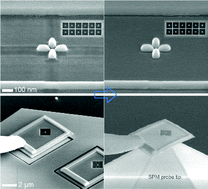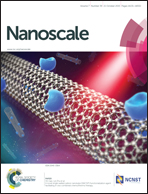Silica–gold bilayer-based transfer of focused ion beam-fabricated nanostructures†
Abstract
The demand for using nanostructures fabricated by focused ion beam (FIB) on delicate substrates or as building blocks for complex devices motivates the development of protocols that allow FIB-fabricated nanostructures to be transferred from the original substrate to the desired target. However, transfer of FIB-fabricated nanostructures is severely hindered by FIB-induced welding of structure and substrate. Here we present two (ex and in situ) transfer methods for FIB-fabricated nanostructures based on a silica–gold bilayer evaporated onto a bulk substrate. Utilizing the poor adhesion between silica and gold, the nanostructures can be mechanically separated from the bulk substrate. For the ex situ transfer, a spin-coated poly(methyl methacrylate) film is used to carry the nanostructures so that the bilayer can be etched away after being peeled off. For the in situ transfer, using a micro-manipulator inside the FIB machine, a cut-out piece of silica on which a nanostructure has been fabricated is peeled off from the bulk substrate and thus carries the nanostructure to a target substrate. We demonstrate the performance of both methods by transferring plasmonic nano-antennas fabricated from single-crystalline gold flakes by FIB milling to a silicon wafer and to a scanning probe tip.



 Please wait while we load your content...
Please wait while we load your content...